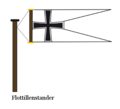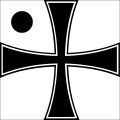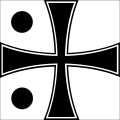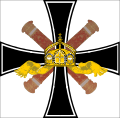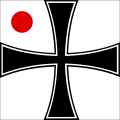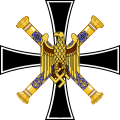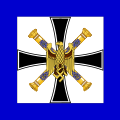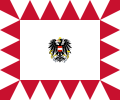Command flag

The command flag (also rank flag , in the navy command symbol, in Switzerland called Fanion ) is a symbol introduced by various armed forces, by which the location of a higher commander is identified.
Germany
marine
The German Navy knows the following command signs in ascending order, which have been used with only minor changes since the time of the Imperial Navy .
German Empire and Federal Republic of Germany
Commander's pennant : international law obliges every commander of a warship in service to fly the commander's pennant in addition to the naval war flag ("service flag of the German naval forces"), provided that he is an officer . The commander's pennant is made of white flag cloth and is printed with a black iron cross on the side of the stick . A special form is the home pennant, which can be set after one year of absence from the home port. It extends from the top of the mast to the ship's wake .
Division stand: The leader of a division, a subdivision of a squadron, is entitled to lead the division stand. The deputy commanders of boat squadrons are regularly appointed as division leaders. The division stand is also made of white flag cloth and printed with a black iron cross on the standing leech, which takes up a little less than the full height of the stand.
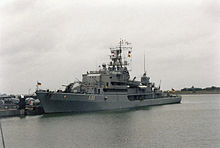
Geschwaderstander: The commander of a squadron is authorized to drive the squadron if he has embarked on board a sea-going unit. On larger ships, the squadron stand measures about 1 m × 1.5 m and is double stiffened, ie cut at right angles on the billowing leech ("dovetail"). It is also made of white flag cloth and printed with a black iron cross on the standing leech, which occupies the full height of the stand.
Group stand: If an officer leads a formation of vehicles that are not also subordinate to him on duty, he leads a group stand. The group Stander corresponds to the squadron Stander in appearance, but not in the mast, but in the starboard - Rah out.
Flotilla stand : The commander of a flotilla is entitled to operate the flotilla stand, provided that he has embarked on board a sea-going unit and is not a flag officer (which is the rule, however, which is why this stand is rarely used). The shape is the same as that of the squadron stand, but this stand is used as a banner, that is, it is drawn up on a stick that ends with golden caps at both ends and is attached in the middle.
Staff flags : Strictly speaking, they are not command signals, but flags that indicate the rank of the officer who is authorized to use them (hence the designation flag officer). Since flag officers are usually command holders, the staff flags are also counted among the command signals. They are all square in shape and made of white flag cloth. A black iron cross also extends over the entire area. In the four compartments that the Iron Cross leaves free, black dots are added to indicate the rank, the fewer the higher the rank: three - Flotilla Admiral, two - Rear Admiral , one - Vice Admiral, none - Admiral .
Boat pennants : In addition, flag officers and generals are entitled to use so-called boat pennants on dinghies of militarily manned warships, which are modeled on the rank symbols on motor vehicles: for admirals these are gold stars on a dark blue background, for army generals gold stars on a red, for the Luftwaffe on light blue Reason. The following applies here: Admiral / General - four stars, Vice Admiral / Lieutenant General - three stars, Rear Admiral / Major General - two stars, Flotilla Admiral / Brigadier General - one star.
The Imperial Navy also knew the following admiral flags:
 ? State Secretary Reichsmarineamt (was not, however, a command flag)
? State Secretary Reichsmarineamt (was not, however, a command flag)
 ? Commanding admiral
? Commanding admiral
 ? Vice Admiral Second Squadron
? Vice Admiral Second Squadron
 ? Rear Admiral Second Squadron
? Rear Admiral Second Squadron
For the navy , new flags were created for the higher commanders, based on those of the Imperial Navy.
People's Navy of the GDR
The traditional German flags were not adopted in the National People's Army of the German Democratic Republic . The new flags were partly based on those of the Soviet Navy .
 ? Chief of the People's Navy
? Chief of the People's Navy
 ? Deputy Minister of National Defense and Chief of Staff, and Deputy Admiral
? Deputy Minister of National Defense and Chief of Staff, and Deputy Admiral
 ? Defense Minister
? Defense Minister
 ? Rear admiral
? Rear admiral
 ? Vice admiral
? Vice admiral
 ? admiral
? admiral
army
In the army of the Bundeswehr , command flags in the form of those of the German Reich are used, only the colors black, red and gold are used (as in the Navy of the German Confederation ) . In addition, new command flags were introduced for units down to company level. These are highlighted with the weapon color of the respective military type .
air force
Italy
Navy of the Kingdom of Italy
 ? Ministro della Marina
? Ministro della Marina
 ? Sottosegretario della Regia Marina
? Sottosegretario della Regia Marina
 ? Grande ammiraglio
? Grande ammiraglio
 ? Ammiraglio d'armata
? Ammiraglio d'armata
 ? Generale d'armata
? Generale d'armata
 ? Ammiraglio di squadra
? Ammiraglio di squadra
 ? Generale ispettore
? Generale ispettore
 ? Ammiraglio di divisione
? Ammiraglio di divisione
 ? Tenente generale
? Tenente generale
 ? Contrammiraglio
? Contrammiraglio
 ? Maggiore generale
? Maggiore generale
 ? Capitano di vascello comandante di divisione
? Capitano di vascello comandante di divisione
Lithuania
Netherlands
In the Dutch Navy, a distinction is made between command flags, which stand for function, and rank flags, which stand for rank.
Austria
Norway
The lion on the flags of the Minister of Defense and the Commander-in-Chief correspond to that on the national coat of arms of Norway. When this was stylized on the coat of arms in 1937, the same thing happened with the lions on the flags. The command signals of the flag officers have remained unchanged since 1905.
marine
Army and Air Force
Portugal
marine
 ? Minister of the Navy
? Minister of the Navy
army
Switzerland
United Kingdom
Royal Air Force
United States
US Coast Guard
US Army
US National Guard
Web links
- Flags of the World - Naval Command Signs
Individual evidence
- ↑ Commanders of small auxiliary ships and landing craft are mostly Portepée NCOs.
- ^ Command Flags and Pennants of Army Units (Germany ), Flags of the World, accessed February 26, 2009
- ^ Flags of the Armed Forces (Germany) , Flags of the World, accessed February 26, 2009
- ↑ Flags of the World - Command and Rank flags (The Netherlands)
- ↑ Flags of the World - 'Pure' National Rank Flags - 1905-


